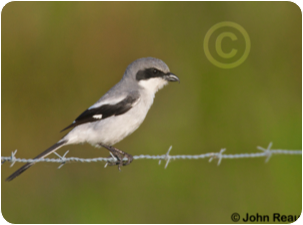By Katherine Robbins (Grey-Bruce and Manitoulin Biologist)
The Eastern Loggerhead Shrike (ELOSH) is a bird that may have been seen regularly on cattle pastures in Grey-Bruce 50 years ago, but you wouldn’t know it today. Wildlife Preservation Canada (WPC) implements the recovery program for this endangered bird and had focused its monitoring efforts mainly in the Carden and Napanee Plains where the majority of remaining pairs return to breed in Ontario. This summer however, WPC hired an additional biologist dedicated to the Grey-Bruce and Manitoulin regions, both still considered important core areas in the northern breeding range of ELOSH that have only isolated records of breeding pairs in the past 20 years. In addition to surveying for shrike across hundreds of kilometres of agricultural lands, a key objective was to foster public awareness and support within communities since this bird relies primarily on privately owned land for its habitat.
This summer I have met dozens of friendly landowners, surveyed hundreds of pastures with scattered hawthorn or apple trees, but ultimately found very few shrikes, painting a bleak picture of this bird’s current local status. Thanks to 32 participants in the 3rd Grassland Bird Survey (GBS) and reports from other community members, a total of 8 shrikes were reported over the breeding season, 5 in Grey-Bruce and 3 in Manitoulin. However, none of these shrikes stayed in the location in which they were originally observed, indicating that these were likely single birds, constantly moving to different suitable patches of habitat in search of a mate. Despite the low count, the presence of shrike reported on Manitoulin Island this year is encouraging since there have been no official records on the Island since 2002.
Two single shrikes observed in Grey-Bruce this season were confirmed as birds originally released from our field breeding and release site in Dyer’s Bay in 2007 and 2010. Captive breeding and release is a conservation technique that is only attempted when a population reaches critically low numbers, putting the animal at risk of losing its genetic diversity. The captive breeding program was established in 1997 when the Ontario population reached its lowest number at only 18 pairs. The field breeding site in Dyer’s Bay has been in operation since 2003 and has released a total of 257 birds by 2010. This year, 44 young were produced at the Dyer’s Bay site. Unfortunately, some of the young produced did not survive, but 16 were released at the site, while the remaining surviving birds were either transferred for release at the Carden Plain field breeding site (due to the high number of Merlins present at the Dyer’s Bay site, a predator of young shrikes), or retained to replace aging birds in the captive population.
Other species at risk seen in the Grey-Bruce and Manitoulin Island regions during the GBS include Bobolinks, Common Nighthawks and Red-headed Woodpeckers. The GBS is a joint effort between WPC, Bird Studies Canada and the Canadian Wildlife Service to determine the diversity and abundance of bird species in our grassland habitats. In addition, learning more about the assemblage of various grassland species will lend a more ecosystem approach to recovery efforts, helping many species at risk. A total of 197 stops were surveyed by volunteer participants between April and July, with 136 species seen.
At community events, meetings and from the individual connections I’ve made this season, I was overwhelmed by the remarkable support expressed for the recovery of this endangered bird. Farmers, landowners and community members showed their support in various ways; from volunteering with the GBS and reporting their sightings, to permitting access to their property for a survey, to making a commitment to preserve habitat on their land. If you’d like to learn more about Shrikes and participating in the recovery effort, visit our website at www.wildlifepreservation.ca or contact us toll free at 1-800-956-6608. Happy fall birding SFN!



